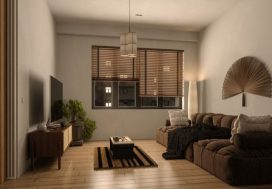Everyone deserves to kick back, relax, and enjoy the fresh air outside their abodes. But, let’s face it, it’s not easy to enter relaxation mode in a space with mismatched furniture pieces haphazardly thrown together.
Placing the right furniture on your patio is the best way to foster a comfortable setting right by your doorstep. With the right pieces, you can promote serenity and relaxation, dedicate extra space to entertain guests, and make playtime more fun for the kids.
But hold on a second! Unless you’ve got a creative eye or are professionally trained, developing the skill to pick the right furniture isn’t easy. So to all the homeowners looking to improve their exterior, here are a few tips for selecting patio furniture.
1) Make A Plan and Theme
Before diving headfirst into patio furniture selection, it’s important to see everything through an overarching plan.
Besides having a rough layout in mind, pick your furniture based on a surrounding theme—you wouldn’t want to make any unfortunate returns from having two or more contrasting pieces of decor.
To kick off the planning process, assess the size and shape of your patio. Knowing the dimensions of your space can help you determine what furniture can fit and how many pieces you can put inside.
Secondly, evaluate the patio’s main purpose. Do you want to make your space a place to accommodate guests or a private oasis for relaxation?
Knowing this is crucial as this can dictate the entire arrangement—the former may require you to get chaise lounges, sectional sofas and long tables, for instance, while the latter would just demand a chair and a couple of key decorative pieces.
2) Choose Durable Materials
Patio furniture is exposed to the elements all year round. You may have found some good furniture pieces, but corrosion and rusting can blemish your furniture set over the years—even high-quality ones. So be careful!
If you live in a region with a climate that can be scorching during summers and frigid during winters, you’ll need to pick furniture sturdy and sustainable enough for the job.
That said, the temperature isn’t the only thing to take into account. It’s also essential to choose furniture that can withstand direct rain, wind, snow, and sun exposure.
In such cases. furniture with materials primarily made from UV-resistant plastic, aluminium, and teak are all excellent outdoor furniture options. Wooden options also work well. Woods like teak and mahogany develop a fine silver colour over time, which can look lovely for the right people.
3) Avoid Cushions…
Inside or outside, we all share the same love for comfortable seating. But if you have a sun-drenched patio, having plush cushions can turn a low-maintenance patio into one that needs weekly—if not daily—upkeep.
Sure, the softness of these items can make hanging out with friends vastly more comfortable. However, soot and wind-blown contaminants can stick to this soft material, causing it to be a haven for unwanted particles.
An alternative to cushions is chairs with a fine net meshing. These seats are cosy enough for people to sit in them for long periods without all the extra fuss of cleaning them.
If you must have cushions, be sure to buy fabric that’s been coloured in during the early stages of the manufacturing process, not dyed later in the process. This is to prevent the colours from fading earlier on.
4) …Or Store Them Instead
If cushions are a mainstay in your overall patio design, you have one saving grace—storage.
During the off-season or on days with harsh weather conditions, you can keep the cushions safe inside containers integrated into your outdoor furniture. This allows you to extend their durability while decreasing upkeep time.
And, by the way, this rule doesn’t only apply to cushions. Even the sturdiest pieces of furniture made from teak can be damaged the longer it sits out in the weather.
As such, always be prepared to store all outdoor furniture from ArchiPro or other retailers in your garage or basement to keep them safe from the elements. You can also keep cushions inside ottomans or couches with enclosed containers.
5) Coordinate with Your Home’s Aesthetic
Even if it’s outside your walls, the patio is still a vital component of your overall home’s feel, so it’s essential to choose furniture that coordinates with your interior’s aesthetic.
For example, if your home has a coastal vibe going on, consider choosing furniture that has a beachy feel. If your home is filled with tonnes of indoor plants, integrate nature into your patio as well.
A sense of cohesion helps clear the mind and makes your entire home flow more seamlessly. If done well enough, you can leave an impression not just with your patio, but in your home’s interior as well.
6) Don’t Forget The Colours
Sure, a large variety of patio furniture pieces come in just wooden or neutral shades. But don’t let that stop you from playing around with bold finishes and eccentric wood types!
Your furniture’s current finish doesn’t have to be the end result either. If your furniture pieces tend to sway towards one colour scheme and you have a piece that’s an odd one out, get your hands dirty and do a DIY paint job.
That said, matching furniture doesn’t always require a uniform shade. You can choose to go bold, play with contrasts, or choose two or more hues—totally up to you.





